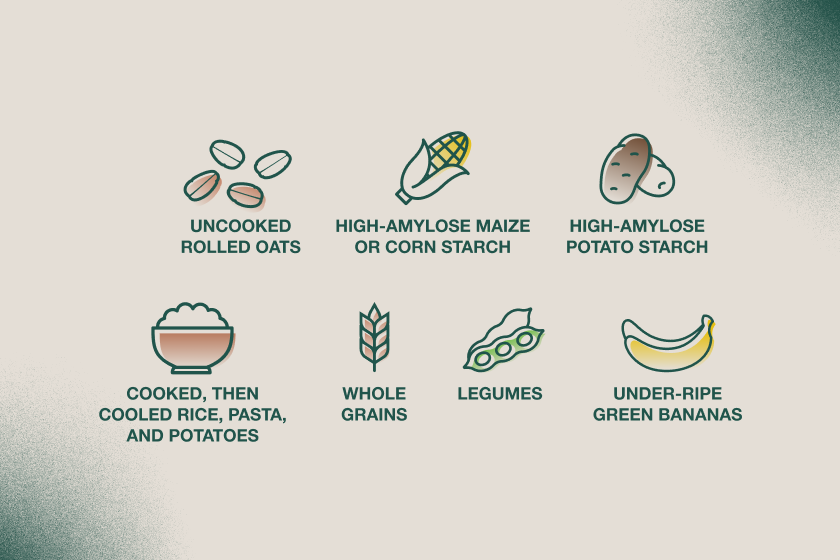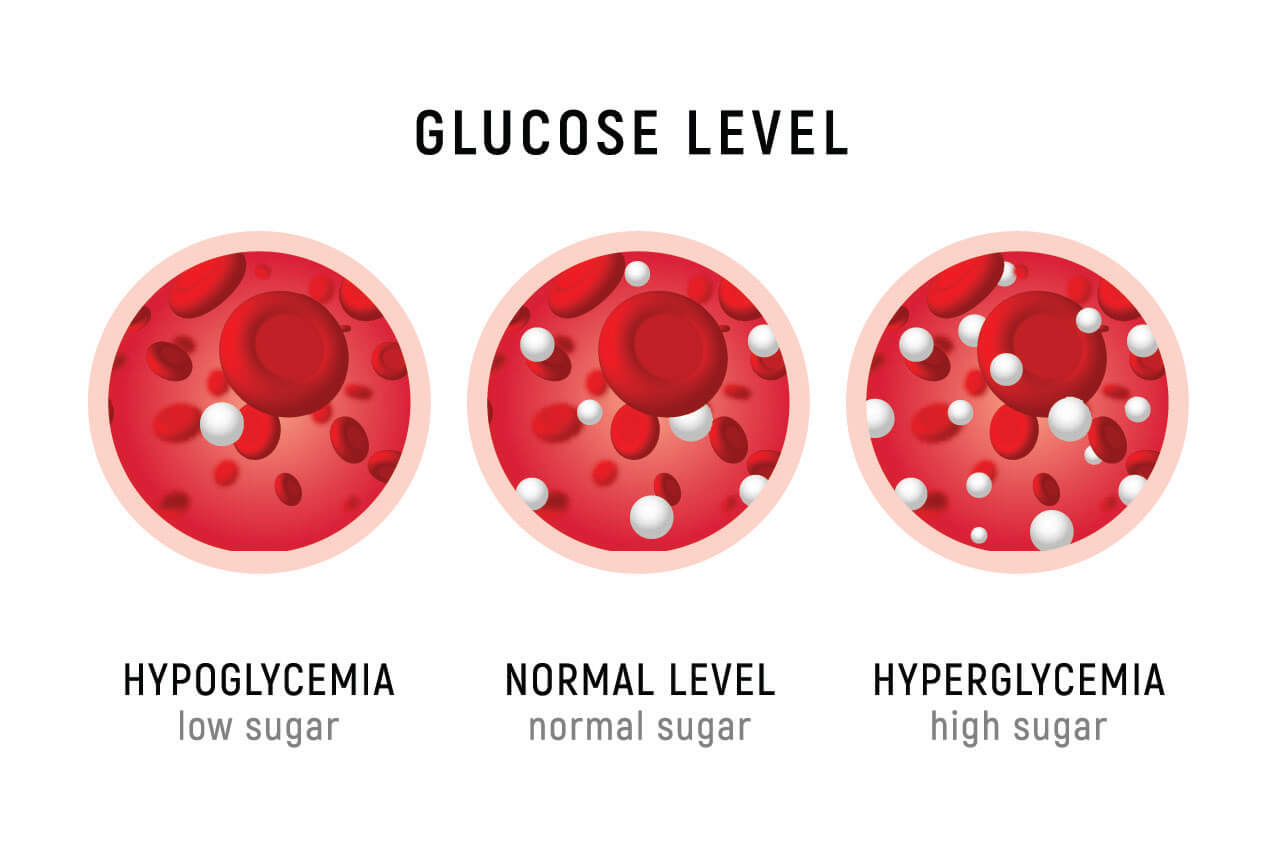It may seem strange that a starch (effectively long chains of sugar molecules) could actually lower sugar levels in your blood. But then again, resistant starch is no ordinary starch.
Resistant starch is a powerful prebiotic fiber that’s been shown to aid in weight loss, improve insulin sensitivity, and yep — lower blood sugar levels, too. [1, 2, 3]
If you’re looking to get control over your blood sugar levels, then turning to a fiber such as resistant starch could be just the game-changing ticket you’re looking for.
A Brief Introduction to Resistant Starch

So, what is resistant starch? Found in a variety of food sources, resistant starch is a carbohydrate and a unique dietary fiber that “resists” digestion in the small intestine and travels mostly intact all the way to your gut to be digested by beneficial bacteria in your microbiome.
But let’s back up a sec. What does that mean “resists digestion?”
Well, normally, when you ingest foods — especially simple carbohydrates — they’re immediately broken down into glucose. Glucose is a sugar. It’s a form of energy for your cells and muscles. In isolation, glucose is good for you.
But if Netflix binges have taught us anything: too much of even a good thing can be bad for us. When your blood sugar is too high, you run the risk of sugar spikes and subsequent crashes. And consistently high levels of blood sugar can lead to, or be signs of, health conditions like diabetes.
So, when we talk about foods that “resist digestion” — like resistant starch and other prebiotic fibers — we’re in a way talking about nourishing our bodies with food yet without digesting food.
If that sounds about as counterintuitive as Reno being west of LA (which it is btw), we get it. But the thing is, there’s a lot more to fibrous foods than initially meets the eye (or small intestine for that matter!).
In fact, there’s an entire unseen ecosystem of trillions of microbial organisms living within us at all times — called the gut microbiome — which plays a huge healing role in your overall well-being. But that’s probably a discussion for another blog post.
Does Resistant Starch Raise Blood Sugar?

So, does resistant starch raise blood sugar? Quite the opposite, actually! Like many forms of fiber, resistant starch doesn’t cause sugar spikes the way other carbohydrates can.
The reason is because our bodies can’t easily break it down. Again, normally, when we consume food, our digestive enzymes are really good at immediately turning that into glucose energy. With resistant starch, however, these digestive enzymes simply aren’t at the races.
Think of it like a boxing match. The digestive enzymes try to land some blows on the resistant starch fibers — you know, break them down a bit. But the various forms of resistant starch are either too strong or too protected by molecular and/or cellular defensive structures to be bothered. They cruise through twelve rounds with barely a scratch.
This means there’s very little blood (sugar) spilled, so to speak. So, instead of our cells having immediate access to that sugar, the resistant starch travels down the intestine, to the colon, where microbes can then liberate the sugar and turn it into all sorts of beneficial byproducts like short-chain fatty acids (SCFAs), B vitamins, amino acids, and more. [4]
In short, our gut microbes are really powerful things. If you give them the chance to prove their worth (by nourishing them with plenty of dietary fiber like resistant starch), then they will repay you with myriad health benefits.
How Resistant Starch may Improve Insulin Sensitivity

Insulin is a hormone produced in the pancreas that regulates the amount of glucose in your bloodstream. It’s what helps deliver glucose to your cells to be used as energy.
When people talk about insulin sensitivity, they’re essentially referring to how responsive someone’s fat or muscle cells are to insulin.
Low insulin sensitivity, or insulin resistance, generally means larger amounts of insulin are required (either from the pancreas or from injections) to take glucose out of the bloodstream and into your cells. Insulin resistance is a sign that your body has difficulty metabolizing glucose.
High insulin sensitivity, on the other hand, can lead to too much sugar in your body and is associated with damage to blood vessels, high blood pressure, and obesity. [5]
The good news is that your gut microbiome can help. According to some studies, gut microbes are what control the release of hormones from the gut that regulate appetite and energy. These include Sci-fi-sounding names like leptin, ghrelin, peptide YY, and GLP-1 (glucagon-like peptide-1). [6]
GLP-1, in particular, is a big one for improving insulin sensitivity. This incretin hormone is shown to enhance insulin secretion, inhibit the release of glucagon (a hormone that raises glucose levels in the bloodstream), and aid in weight management. [7]
GLP-1 is also the mechanism by which resistant starch specifically can help rebalance your microbiome, improve insulin sensitivity, and even aid in healthy weight management. [8] By consuming foods high in resistant starch, you can boost your microbiome’s ability to unleash powerful metabolic soldiers like GLP-1.
Lowering Blood Sugar with Resistant Starch: What People Living with Diabetes Should Know

As most people living with diabetes know, optimal blood sugar levels range from about 70-140 mg/dl (milligrams per deciliter). Hyperglycemia is when blood glucose greater than 125 mg/dL while fasting and greater than 180 mg/dL 2 hours after eating. [9]
When your blood sugar is chronically high, this causes damage to muscle and fat cells, nerve cells, the kidneys, even the brain. This is because our cells quite literally become too coated in sugar. Too much sugar coating essentially means the machinery won’t work as well. If you have chronically high blood sugar levels, then that imbalance can become type 2 diabetes by rewiring your metabolism.
Chronically high glucose and insulin also puts stress on the pancreas. Because the pancreas is constantly pumping out insulin in an effort to control the amount of glucose in the bloodstream, this can lead the pancreas to eventually “burn out” and produce less insulin. When this happens, you have the double-burden problem of both insulin insensitivity and low insulin. This explains why some people with type 2 diabetes eventually go on insulin therapy.
Fortunately, both blood sugar levels and insulin sensitivity can be improved with a change in lifestyle. This includes getting more exercise. It also includes eating better.
The role that diet can play in minimizing the effects of metabolic health conditions is huge. More and more studies are beginning to show that high intake of dietary fibers (such as resistant starch) can improve glycemic control, reduce the risk of metabolic health conditions, and lead to a longer healthspan. [10]
How Resistant Starch Helps

One intuitively cool thing about incorporating more resistant starch into your diet is that you’re effectively getting two health benefits for the price of one:
- You get the blood sugar stabilization benefits that come along with resistant starch itself
- You’re also more than likely subbing out bad actors like simple carbs and processed foods in favor of healthier RS alternatives
Talk about a win-win! It’s like a pulley system of health. Additive good stuff on one side, subtracting bad stuff on the other. Which balances out to a healthier you.
Does Resistant Starch Raise or Lower Blood Sugar? Wrapping Things Up

In sum, resistant starch is a plant-based powerhouse. It does an excellent job of skipping early-phase digestion, which reduces blood sugar spikes and crashes. In turn, it feeds the good bacteria in your gut, grows their numbers, and unleashes a series of short chain fatty acids (SCFAs), as well as other beneficial metabolites, which have profound health-healing capabilities.
There’s even strong evidence to suggest that resistant starch can improve glycemic control.
In our own gold-standard double-blind clinical trial at Supergut, we saw significant improvements in blood sugar control. Over the course of 12 weeks, participants lowered their A1c levels by 0.7%. As a refresher, A1c is a simple blood test that measures your average blood sugar levels over three months. In other words, resistant starch can have long-lasting, compounding health benefits when consumed consistently over time.
If you want to lower your blood sugar with resistant starch and improve your overall health through the power of your gut, then this is your movement and Supergut can help.








